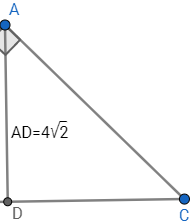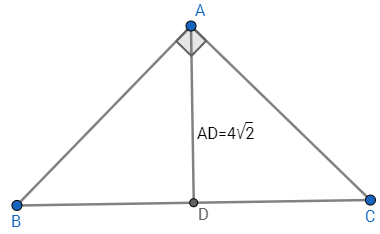
I know why the guest got this question incorrect. Let's assume that \(m\angle ADC=90^{\circ}\), thus making it a right triangle. Let's make the assumption, too, that \(AD=DC\), thus making it an isosceles triangle.
| \(\frac{\left(4\sqrt{2}\right)^2}{2}\) | This utilizing the triangle area formula. |
| \(\frac{16*(\sqrt{2})^2}{2}\) | |
| \(8*\sqrt{2}^2\) | |
| \(8*2\) | |
| \(16units^2\) | |
However, there is a key word. That word would happen to be "altitude." An altitude is a perpendicular height that extends from a vertex to the opposite side. Notice how the height of this triangle does not do this. Therefore, the original diagram does not fit the original criteria.

This is a sketch of the given info. \(\overline{AD}\) is an altitude and \(\overline{AC}\cong\overline{AB}\), and the triangle is right.
Because \(\overline{AC}\cong\overline{AB}\) by the given info, the isosceles triangle theorem tells us that the angles opposite of their sides are congruent, so \(\angle B\cong\angle C\). We can now figure out \(m\angle B\quad\text{and}\quad m\angle C\).
| \(m\angle B+m\angle C+m\angle BAC=180^{\circ}\) | Now, substitute in the known values. |
| \(m\angle B+m\angle C+90=180\) | \(m\angle B=m\angle C\) |
| \(m\angle B+m\angle B+90=180\) | Now, solve for both angles. |
| \(2m\angle B+90=180\) | |
| \(m\angle B+45=90\) | |
| \(m\angle B=45^{\circ}\) | |
| \(m\angle B=m\angle C=45^{\circ}\) | |
Since an altitude always bisects the angle of an isosceles triangle, \(m\angle CAD=\frac{1}{2}*90=45^{\circ}\).
Since \(m\angle CAD=m\angle C=45^{\circ}\), by the inverse of the isosceles triangle theorem, \(AD=DC=4\sqrt{2}\)
The entire base, however, is 2 times this length, so \(BC=2*4\sqrt{2}=8\sqrt{2}\). The altitude is \(4\sqrt{2}\). Now, let's use the area formula for a triangle.
| \(\frac{1}{2}bh=\frac{1}{2}(8\sqrt{2})(4\sqrt{2})\) | Now, simplify here. |
| \(\frac{1}{2}(32*\left(\sqrt{2}\right)^2)\) | |
| \(\frac{1}{2}(32*2)\) | The 1/2 and 2 cancel out here. |
| \(32\) | This is the area of the triangle. |
The length of \(\overline{AC}\) can be found using the law of cosines. The law of cosines relates the remaining side by knowing two sides and its opposite included angle. I think this picture sums it up nicely.

Knowing this information, we can now find the missing length.
| \(c^2=a^2+b^2-2ab\cos C\) | Now, plug in the values we already know in the diagram and solve for the missing side. |
| \(AC^2=1^2+3^2-2(1)(3)\cos40^{\circ}\) | Now, take the principal square root of both sides since the negative answer is nonsensical in the context of geometry. |
| \(AC=\sqrt{1^2+3^2-2(1)(3)\cos40^{\circ}}\approx2.32\) | No units are given in the problem. |